William deBuys reports on the humanitarian and environmental disaster of Trump’s border wall.
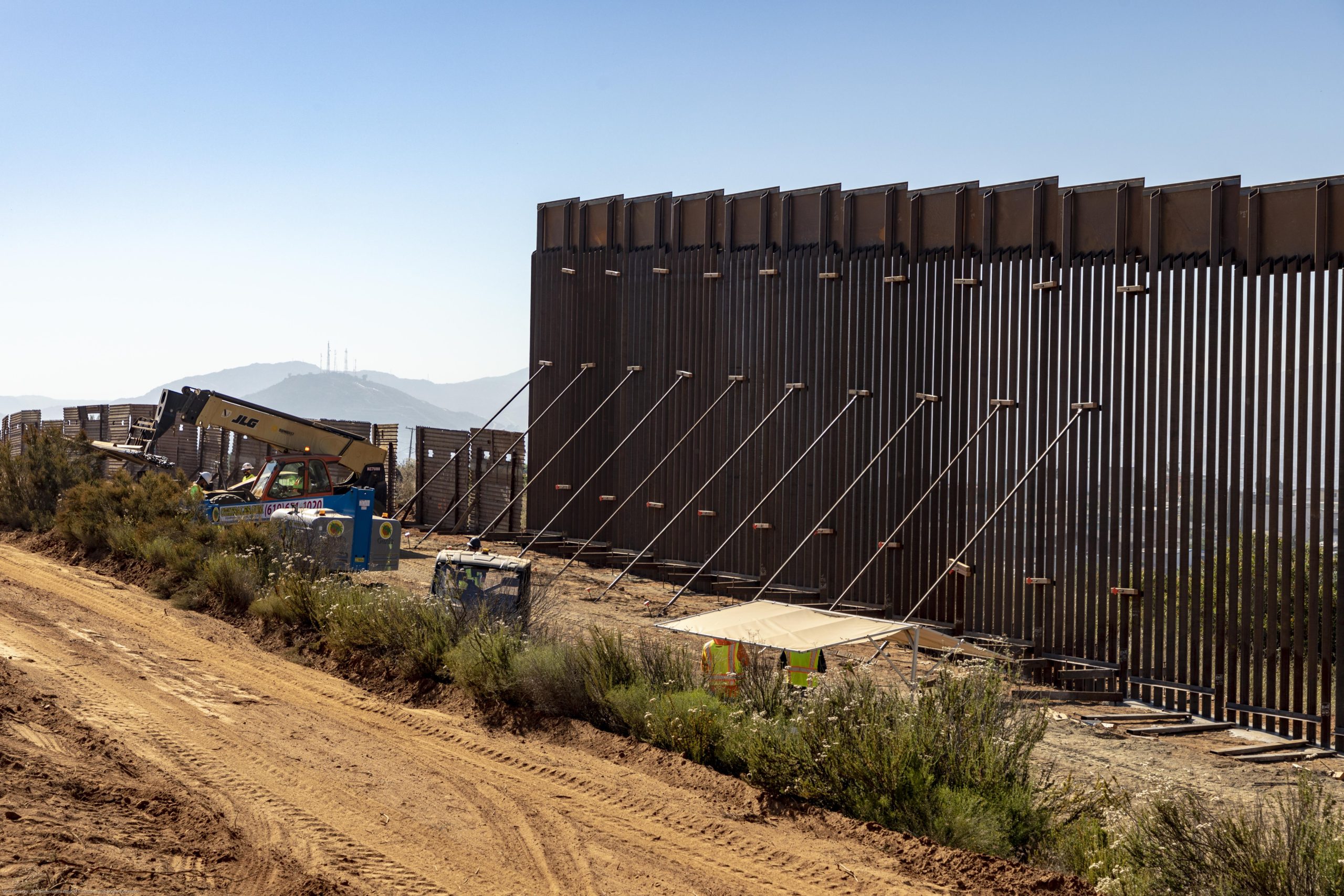
Replacement border fencing construction in California in 2019 near the Tecate Port of Entry. (U.S. Customs and Border Protection)
By William deBuys
TomDispatch
 A new Wild West has taken root not far from Tombstone, Arizona, known to many for its faux-historical reenactments of the old West. We’re talking about a long, skinny territory — a geographic gerrymander — that stretches east across New Mexico and down the Texan Rio Grande to the Gulf of Mexico. It also runs west across hundreds of miles of desert to California and the Pacific Ocean. Like the old Wild West, this one is lawless, save for the law of the gun. But that old West was lawless for want of government. This one is lawless because of it.
A new Wild West has taken root not far from Tombstone, Arizona, known to many for its faux-historical reenactments of the old West. We’re talking about a long, skinny territory — a geographic gerrymander — that stretches east across New Mexico and down the Texan Rio Grande to the Gulf of Mexico. It also runs west across hundreds of miles of desert to California and the Pacific Ocean. Like the old Wild West, this one is lawless, save for the law of the gun. But that old West was lawless for want of government. This one is lawless because of it.
The Department of Homeland Security, under authority conferred by Congress, has declared more than 50 federal laws inoperable along sections of the U.S. boundary with Mexico, the better to build the border wall that Donald Trump has promised his “base.” Innumerable state laws and local ordinances have also been swept aside. Predictably, the Endangered Species Act is among the fallen. So are the National Historic Preservation Act, the Wilderness Act, laws restricting air and water pollution, and measures protecting wildlife, landscapes, Native American sacred sites, and even caves and fossils.
The new Wild West of the border wall is an authoritarian dreamscape where the boss man faces no limits and no obligations. It’s as though Marshall Wyatt Earp, reborn as an orange-haired easterner with no knowledge of the actual West, were back in charge, deciding who’s in and who’s out, what goes and what stays.
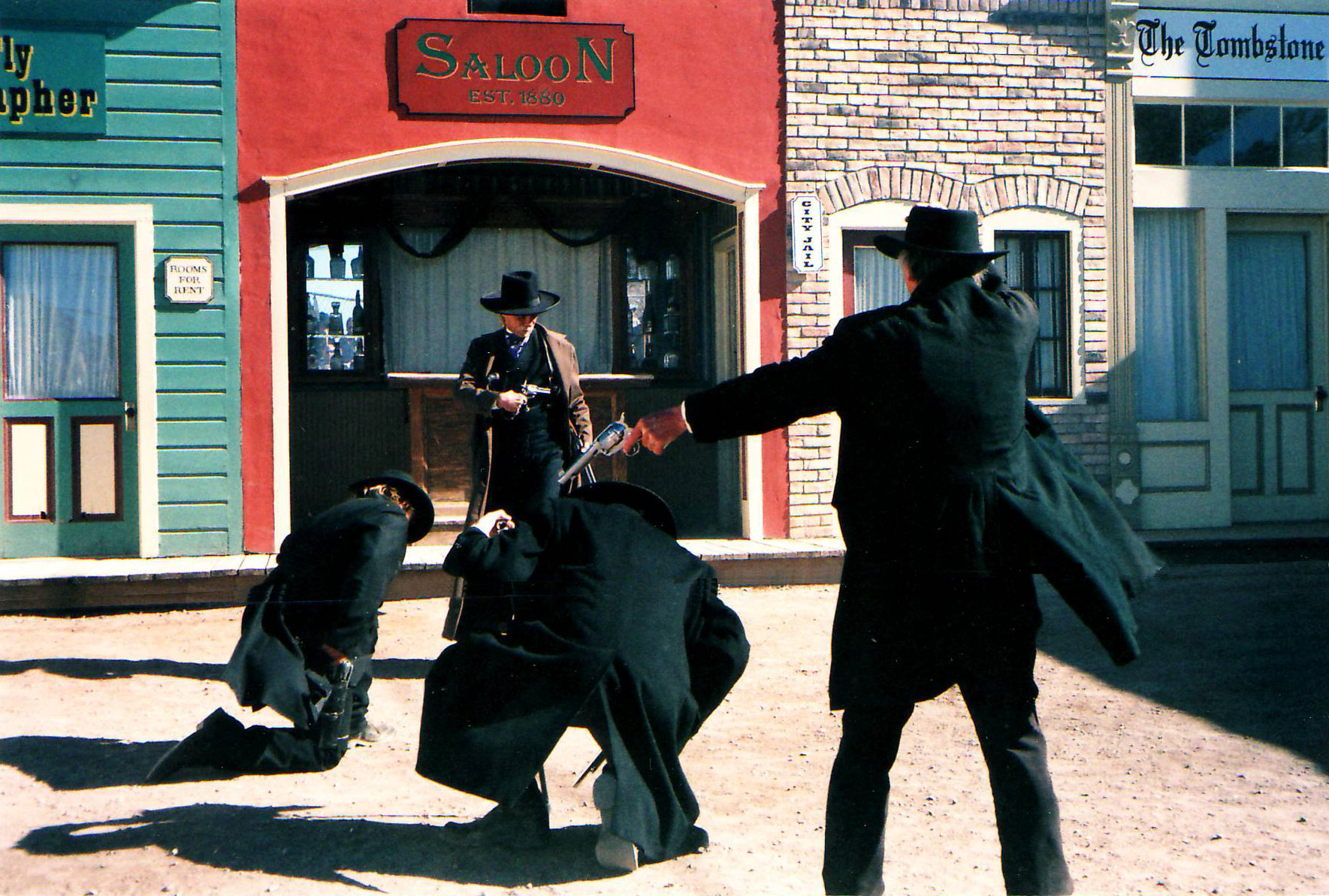
Reenactment of the Gunfight at the O.K. Corral, Tombstone, Arizona, 2006. (James G. Howes, Wikimedia Commons)
Prominent on the list of suspended laws is the 1970 National Environmental Policy Act, or NEPA, which, until recently, was the nation’s look-before-you-leap conscience. The environmental analyses and impact statements NEPA requires might not force the government to evaluate whether a palisade of 30-foot-high metal posts — bollards in border wall terminology — were really a better way to control drug smuggling than upgrading inspection facilities at ports of entry, where, by all accounts, the vast majority of illegal substances enter the country. They would, however, require those wall builders to figure out in advance a slew of other gnarly questions like: How will wildlife be affected by a barrier that nothing larger than a kangaroo rat can get through? And how much will pumping scarce local water to make concrete draw down shallow desert aquifers?
The questions get big, fast. One that might look easy but isn’t concerns the flashfloods that stream down desert washes. The uprights of the border wall are to be spaced only four inches apart, which means they’ll catch flood debris the way a colander catches spaghetti.
Let’s get specific. The San Bernardino National Wildlife Refuge abuts the border in the far southeastern corner of Arizona. Black Draw, a gulch running through the middle of the refuge, is normally as dry as a hot sidewalk. When thunderstorms burst over the vast San Bernardino Valley, however, the floodwaters can surge more than 20 feet high. Imagine a wall of chocolate water sweeping up tree trunks, uprooted bushes, the occasional dead cow, and fence posts snarled in wire. Imagine what happens when that torrent meets a barrier built like a strainer. The junk catches and creates a dam. Water backs up, and pressure builds. If the wall were built like the Hoover Dam, it might hold, but it won’t be and it won’t.
In 2014, a flood in Black Draw swept vehicle barriers aside, scattering pieces downstream. Local ranchers have shown me the pictures. You could say the desert was making a point about how wet it could be. In fact, there’s no mystery about what will happen when such a flood hits a top-heavy palisade. If a NEPA document were to evaluate the border wall, the passage discussing this eventuality might require its writer to invent a term for what a wall becomes when it lies flat on the ground.
On the other hand, if you leave gaps for floods to pass through, then smugglers and — for Donald Trump and his base — people of unacceptably dark skin color might come the other way. Not that they necessarily would. As local residents I talked to attest, active patrols, remote sensing, and improved coordination among law enforcement agencies have reduced illegal crossings in the San Bernardino Valley almost to zero, something current government officials don’t point out but a NEPA document would.
With NEPA out of the picture, the responsible parties only have to claim that they’ll figure out a solution later and, when “later” comes, maybe they’ll have conveniently moved on to other jobs.
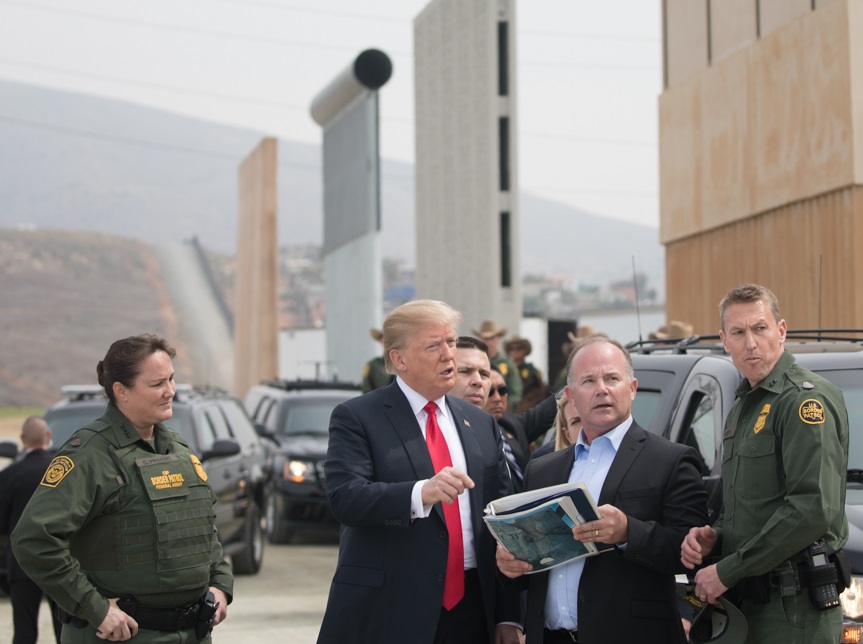
President Donald Trump looking at new border wall prototypes in San Diego, March 2018. (Wikimedia Commons)
Pittsburgh on the Border
Meanwhile, there’s another question that won’t have to be dealt with: How much water will the wall’s construction require? The answer matters in an area where water’s scarce. Again, the San Bernardino National Wildlife Refuge offers a useful vantage point for considering the question.
To get to the refuge, you drive east from the town of Douglas along the Geronimo Trail, an unpaved two-lane country road that earns its name honestly. Nineteenth-century Apache leader Geronimo surrendered to the U.S. military in the mountains on the horizon just ahead of you. Shortly before you reach the refuge, you top a low rise overlooking what the local assessor initially mistook for a new industrial park. It was as if a section of Pittsburgh or Youngstown had suddenly sprouted from the desert, with enough mesquite and creosote bush scraped away to accommodate a concrete-batching plant, office trailers, and a massive staging area and machinery yard.
Stacks of steel bollards stand taller than houses, covering the space of a neighborhood. A grid of steel rails for laying out those bollards and welding them into pre-fab wall sections occupies another acre or two, beyond which stacks of completed sections cover yet more acres. In front of those stacks, a few scraps of wall stand vertical but disjointed, like shrines to a metal god — probably practice erections, if you’ll pardon the phrase. Scattered through the site are forklifts, graders, loaders, bulldozers, excavators, pickup trucks, flatbeds, and cranes. Generators and floodlights on wheeled rigs are parked at the margins, ready to illuminate round-the-clock shifts. Close to the batching tower, which may rival the Gadsden Hotel in Douglas as the tallest structure in Cochise County, cement trucks cluster like a litter of puppies.
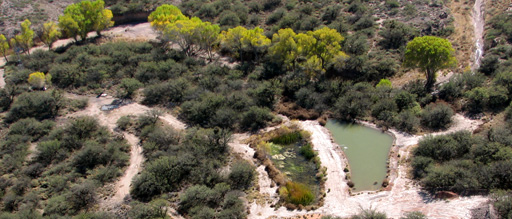
Hay Hollow Ponds, San Bernardino National Wildlife Refuge, Arizona. (C. Lohrengel/USFWS, Wikimedia Commons)
And more steel keeps arriving. An approaching cloud of dust on the Geronimo Trail signals a line of incoming semis loaded with still more bollards. They pass newly posted signs that say: “Be Aware: Equipment Has the Right of Way” and “Risk Takers Are Accident Makers.”
These details, however, are prelude to the main event. If you look toward Mexico, a half-mile of wall already stands in place, undulating with the hills. Think of it as a dark, linear Steelhenge, a monolith screening the shimmering Sonoran mountains to the south. You can see where the next sections will be raised. Construction has already reached the refuge.
Where the Deer and the Antelope Better Not Play
The surface and subsurface flow of water from nearly the entire San Bernardino Valley converges at the refuge, creating an oasis in the heart of the desert. If this were the Sahara, caravansaries would have stopped by its green pools for thousands of years. As it is, Apaches, Yaquis, Tohono O’odham, and their predecessors have used its waters since time out of mind, as did the Spaniards, Mexicans, and Americans who later strove to take the land from them and from each other. The ponds lie half-hidden amid jungles of reeds.
San Bernardino National Wildlife Refuge is modest as refuges go — only 2,369 acres — but it was once part of the sprawling, 73,240-acre Slaughter Ranch, two-thirds of which lay in Mexico. Next to the refuge, the ranch headquarters, now a historic site, has its own big pond. From that pond or any of those on the refuge, a major-league slugger could knock a baseball out of the country.
Contractors building the wall have drilled three wells along the border and leased a fourth. Tanker trucks constantly shuttle between the wells and the concrete plant. Nobody is saying how much water wall construction will consume. The foundation for the wall will be — what? A yard wide and seven-feet deep? Ten-feet deep? Sorry, that’s privileged information, not for public consumption.
Anyway, the foundation just in this area will run for scores of miles, farther than you can see, and consume enough concrete to build a small town — and concrete requires water. Lots of it.
How much will the pumping deplete local aquifers? Nobody knows because, absent NEPA, nobody has had to figure it out. There’s been no modeling, no serious testing, no reliable calculations. Still, local ranchers would like to know the answer. They depend on wells and water tanks scattered through the desert scrub where their cattle drink.
Good luck to them. And good luck, as well, to the critters for which the refuge is supposed to provide… well, refuge.

Chiricahua leopard frog a threatened species from Coconino National Forest, Arizona. (Jim Rorabaugh/USFWS, CC BY 2.0, Wikimedia Commons)
I could print a list of the unusual fish, frogs, snails, snakes, and other living things that are found here and almost nowhere else on Earth, not to mention the rare plants, the itinerant mammals (some also rare), and the hundreds of species of birds that use this place. In the desert, reliable water is a kind of miracle that attracts and creates other miracles.
San Bernardino National Wildlife Refuge, you might say, is a cluster of miracles. There are too many to list. And a long list of weird names would take up a lot of space and sound pinheaded. I care a lot about those creatures, but I don’t want to sound like that.
To be honest, I’m almost afraid to learn the names of some of the refuge’s creatures because then it would only hurt all the more if they decline to extinction. The wall will certainly nudge, or maybe shove, many of them in that direction. Nevertheless, I have to mention two of them. Their names suggest a kind of taxonomic poetry, a nature music. They aren’t necessarily the rarest, but they sound the best: Yaqui topminnow. Chiricahua leopard frog. The words fall on the ears like melodies, evoking the mystery of tender life in a harsh land. As members of a species, you and I are as common as coal. In the big biological scheme of things, creatures like these are rubies and sapphires.
Forget Policy, Follow the Metaphor
It’s impossible to understand the wall, at least in the San Bernardino Valley, in terms of policy. As one rancher put it to me over coffee at the Gadsden Hotel, “This [wall] may be needed someplace, but it isn’t needed here.”
If Trump’s wall were really about policy, its advantages and disadvantages would be weighed against other strategies requiring different kinds of investment. But this is the new Wild West, where rational judgment, laws, and procedures only get in the way.
The truth of the wall lies in metaphor. If Chiricahua leopard frog conveys a kind of poetic resonance to people like me, then for millions of others chanting “Build the Wall!” is like hitting a big bass drum. Everybody understands wall! Even if the structure doesn’t actually work in physical space, it works in your mind. It stands between you and everything bad you can imagine. The core truth that unites Trump and his supporters is that he hates who we hate – and the border wall stands for keeping out those unwanted people and all they represent.

Yaqui topminnow. (W. Radke/USFWS, Wikimedia Commons)
This is why the wall can’t coexist with NEPA. Impact statements don’t do imagery. If you really want to crack down on drug smuggling, for example, you’d concentrate your efforts at established ports of entry, where billions of dollars of goods and millions of people cross from one country to the other every day. The bulk of the fentanyl, cocaine, heroin, and other hard drugs entering the U.S. is reportedly concealed among legitimate imports in railroad cars and trucks of every description. Or they get stashed in secret compartments in buses, vans, cars, and pickup trucks. (The U.S. mail is another major conduit.) Currently, it’s estimated that more than $4 billion in new scanners, inspection lanes, and the people to staff them are needed. Making that investment would have infinitely more impact on drug flow than using the same money to install bollards where they aren’t needed and won’t last. There are better ways to handle people, too, but let’s not get distracted from the real story.
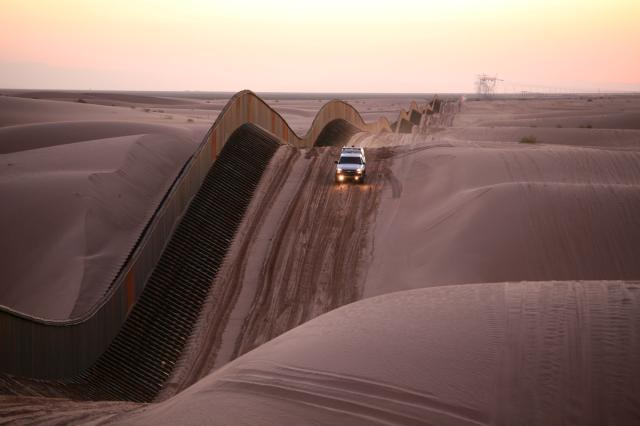
Area of the U.S.-Mexico border that can be shifted up and down with the movement of the sand dunes. (US Border Patrol via Wikimedia Commons)
Expenditures on wall construction in Fiscal Year 2019 ran to approximately $10 billion. Only a third of that amount was actually appropriated by Congress for border security structures. Delivering the rest of the money required masterful circumventions of constitutional intent.
Here’s one of them: each year Congress appropriates so-called 2808 funds to the Department of Defense for construction projects on military bases, including schools, clinics, roads, and other infrastructure. Such expenditures are restricted to military property and the international border with Mexico isn’t — or wasn’t — a military base. For the Trumpistas, however, not a problem.
In 1907, President Teddy Roosevelt reserved a 60-foot easement from the public domain along the southern border to keep it “free from obstruction as a protection against the smuggling of goods between the United States and Mexico.” Since then, the “Roosevelt easement” has been administered by the Bureau of Land Management, but last year the Trump administration transferred the easement to the Department of Defense, which obligingly assigned it as a real-estate asset to Fort Bliss, Texas.
Voila! Now, the Roosevelt Easement is part of a military base and a tendril of Fort Bliss officially extends into Arizona, New Mexico, and California — but not Texas. (The Lone Star State reserved its public land for itself when it entered the union, so no Roosevelt Easement there.) Technically, border wall construction within the easement now constitutes an improvement to Fort Bliss, enhancing military preparedness, yadda, yadda, yadda. There’s more to it than that, including the president’s formal declaration of a national emergency last February, which enabled certain other steps, but you get the idea. Where there’s a will, there’s an imperial way.

“Build the Wall” rally in The Villages, Florida, January 2019. (Whoisjohngalt, CC BY-SA 4.0, Wikimedia Commons)
As it happens, however, the Pentagon’s money for funding wall construction across the foot of the San Bernardino refuge itself comes from a different pot: “284” funds, intended for counter-narcotics work. Diverting $2.5 billion of these monies to the border wall was, to say the least, a stretch, so a coalition of humanitarian and environmental groups sued. A district court found in their favor and issued an injunction, halting the use of the funds for construction. A rapid series of appeals went to the Supreme Court and the Supremes said, Hmmm, interesting question, which will take time for the lower courts to resolve; meanwhile, the injunction is lifted. And so funding again flowed like a flash flood. If the courts ultimately decide that the transfer of funds is really not okay, the wall may already have been built. Thank you, Supremes.
Dollars and Nonsense
I forgot to mention something: in addition to suspending more than 50 laws protecting lands, wildlife, and the public interest, the government has also waived many procurement laws and also buried a lot of contract information. This means you and I will have a hard time learning what anything actually costs, even though our tax dollars are paying for it.
Example: the barrier to be built along the edge of the San Bernardino refuge, cutting off its terrestrial wildlife from the Mexican half of its world and quite possibly draining the ponds where some of the planet’s rarest creatures survive, is part of a contract for 63 miles of border wall awarded to Southwest Valley Constructors (SWVC), a subsidiary of Kiewit, a Fortune 500 company with $9 billion in annual sales.
The original May 2019 contract awarded $646 million to SWVC, putting the cost of the refuge wall at $10.25 million per mile, a veritable steal. But you would need to know someone who can log into the relevant government database to discover that the fifth modification of the original contract, signed on August 29th, added another $653 million to the kitty. Now, those 63 miles are going to cost $1.3 billion, or almost $21 million per mile.
And by the way, did I mention that construction will include a power line and floodlights on 60-foot masts to illuminate the wall all night long, every night of the year? I have friends in the San Bernardino Valley who just about weep — and they aren’t weepy people — when they think about the lights on that wall blazing away in what used to be the immense, holy darkness of their formerly unblemished land.
I can get pretty choked up about it myself, but you can be sure that smugglers won’t. Here’s where things get truly weird: believe it or not, darkness is an ally of the U.S. Customs and Border Patrol (CBP). Its people have night vision goggles and its drones and other sensors have infrared detectors. They don’t need light. Flood the border with light and, counter-intuitively, the CBP is blinded, losing an advantage. Whose idea was this? Nobody’s saying, but it seems to have come from, ahem, the highest level. Good thing NEPA doesn’t apply.
Let’s turn up the weirdness a little bit further: out in western Arizona, close to the California line, you come to the Barry M. Goldwater Range (BMGR). Here, young Air Force and Marine pilots learn to strafe and bomb. Migrants have been known to cross the international border at the BMGR but, according to court filings, over the past five years migrants have gotten in the way of only 195 of 255,732 air sorties – less than 0.1 percent.
An already existing pedestrian barrier along much of the range’s border possibly contributes to this low level of trespass — and the bombs and bullets may help, too. But the decisive factor is undoubtedly the range’s spectacular heat and aridity and the mortally long distances a migrant would have to walk to reach any possible pick-up or rendezvous spot. Nevertheless a second wall, backing up the first, is now slated for construction at BMGR, with a road sandwiched between the two walls, down which CBP patrols will race like hamsters on a flattened wheel.
Let’s just agree, as former Joint Chiefs of Staff Chairman General Joseph Dunford, Jr., did in a memorandum to then-acting Secretary of Defense Patrick Shanahan, that double-walling the BMGR makes no sense in terms of policy. In terms of metaphor, however, double-walling a border where essentially nobody goes is perfectly logical. If the goal is to build miles of wall, costs and benefits be damned, you might as well build them where there’s nobody to get in the way. Build the wall!
And so it is indeed being built, at the cost of violating not just the San Bernardino National Wildlife Refuge, but Cabeza Prieta National Wildlife Refuge, Organ Pipe National Monument, the Lower Rio Grande National Wildlife Refuge, the Santa Ana National Wildlife Refuge, the historic town center of Roma, Texas, and other sublime and exceptional places. One might ask why so much uniqueness and rarity lies along our southern border. The short answer is that the borderlands are the meeting place of biological communities as well as cultures. As Chicano performance artist Guillermo Gómez-Peña puts it, “The border is the juncture, not the edge.”
But an edge is exactly what President Trump’s wall would make it. Wall construction was and remains his foremost campaign pledge: 500 miles of wall by November of 2020, or 450 miles, or whatever the number du jourhappens to be. Speaker Nancy Pelosi, the Washington Post, and others have tried to deflate the president’s boasts by asserting that he’s actually built no new wall and his promises are empty.
In their calculations, substituting a 30-foot-tall wall for vehicle barriers is only “replacement” and therefore doesn’t constitute “new” construction. That’s like arguing that mooring an aircraft carrier where a rowboat used to be changes nothing because there’s still just one vessel in the harbor. Such semantic jousting only camouflages the pervasive damage already being done both to people and to the land on the border — and there’s no end in sight. The congressional budget agreement hammered out in December 2019 appropriates another $1.375 billion for wall construction for fiscal year 2020, while removing obstacles to yet more transfers of Pentagon funds. And Trump is not being shy about those transfers. He evidently plans to divert $7.2 billion more from legitimate Pentagon projects to wall building this year.
The international drug cartels should be thanking us. The wall will not curb their principal business of smuggling and the Trump administration’s new immigration policies have turned what was formerly a minor sideline — kidnapping people for ransom — into a growth industry. Tens of thousands of asylum seekers to whom the U.S. has refused entry are now huddled in cardboard slums in Mexico’s border towns, vulnerable to human predators. Their relatives in the United States — the people they were trying to reach — will beg, borrow, or steal to pay the ransoms that the increasingly busy (and brutal) kidnappers in Mexico demand.
That, however, is just collateral damage in the land of the free. Of course, we treat asylum seekers as though they were an inferior variety of human being. They talk funny. They aren’t like us. And we treat the borderlands and its creatures with the same loyalty we showed the Kurds. After all, we are America. Behind our wall, we are great again.
William deBuys, a TomDispatch regular, is the author of nine books, including “The Last Unicorn: A Search for One of Earth’s Rarest Creatures” and “A Great Aridness: Climate Change and the Future of the American Southwest.”
The views expressed are solely those of the author and may or may not reflect those of Consortium News.
Please Donate to the Winter Fund Drive.
Before commenting please read Robert Parry’s Comment Policy. Allegations unsupported by facts, gross or misleading factual errors and ad hominem attacks, and abusive or rude language toward other commenters or our writers will not be published. If your comment does not immediately appear, please be patient as it is manually reviewed. For security reasons, please refrain from inserting links in your comments, which should not be longer than 300 words.

One can use an abundant amount of facts available to build almost any case, especially today.
This writer leaves out the facts involving the impact on this border environment huge numbers of people have had on it over many decades now. That human footprint is deep because of measures like sanctuary policies that disable law enforcement capabilities along with many enabling magnets involving free education, medical care and subsidized living factors. A narrative has been developed enabling this and now Trump has produced at least a partial contrary narrative.
Of course just implementing an enforceable E-Verify would provide a much more effective and environmentally less impactful solution to our unsustainably absorbing illegally and legally millions of people per year.
If what you say is true, then provide citations proving your claims.
Why is it that the majority of people who actually live near the Mexican border are opposed to the wall?
See: npr.org/2019/01/09/683748179/border-residents-remain-skeptical-about-the-need-for-an-expanded-wall
This article shows that our “stable genius” (I assume due to hanging around polo ponies) POTUS cannot think past the nose on his orange face. Like a petulant 3-year old, Trump wants his wall DAMNIT! Aside from his misuse of presidential emergency powers (this being just 1 of many examples), it paints a very ugly picture of America and our values. Related, in NYT today, was an article about fat middle-aged rednecks in camos pretending to be police and arresting suspected illegals armed to the teeth with military weaponry. It would probably be safer to vacation these days in Venezuela than to hang around our SW borders.
Lifelong registered Democrat here, formerly of California, now living in Hong Kong. Long time Consortium fan, too. As a former teacher of government and political science, I remind the author and readers that one of the essential ingredients of a nation-state is having borders. We have a border, but we have not had effective enforcement along the southern wilderness areas for decades, resulting in some pretty serious problems that have nothing to do with race. You should try to sneak in to Hong Kong! or any other self-respecting nation! You will get your butt handed to you pretty quick, my friends. Incredibly, this author blames President Trump for an increase in the very human trafficking that the Wall seeks to eliminate, among other goals. Wall-Haters can’t have it both ways; either there is and has been a big problem with human trafficking, drug trafficking, money laundering, and illegal immigration across the unWalled border that needs to be addressed, or there isn’t a problem. (Sorry, but the naked truth is that most people really don’t care about the frogs as much as about the gigantic problems of having a border without a Wall. The frogs will be fine.) Moreover, you can’t maliciously blame President Trump for increasing human trafficking and still be taken seriously as a contributor. You can’t ignore that the cages were used by the Obama administration and were ended by the Trump admin. You can’t ignore that illegal crossings are down, and that it was President Trump who negotiated with the government of Mexico to stop the phony Soros caravans.
And now Congress has passed the USMCA the President created, which benefits Mexico also, and scrapped the horrible job-killing NAFTA. Further, the author recklessly and mendaciously accuses President Trump – and his tens of millions of supporters like me – of racism. We commenters are strictly forbidden from using ad hominem attacks: how is it that contributors can level such hideous accusations? I am a Democrat, and I thank god for President Trump (who is only a Republican for electoral purposes – he always leaned Democrat in his opinions and predilections and he is a huge fan of John F. Kennedy as I am and was a close friend of JFK Jr.) and I support his policy of strengthening the border, whether the NIMBYs in the neighborhood like it or not.
Make America Great Again by building a Great Wall. All this money could be going to save lives in Appalachia, in urban slums, and sorry, but in middle class America as well. There really is not much more to say. Thank you for this article.
The Wall is a symbol without teeth, like the Paris Accords, it is Happy Talk for Trump’s Base. The amount of money is trivial, stolen by Trump from bloated military budgets, just as Bill Clinton stole much more (after Congress pointedly said “NO!”) to buy up the Mexican banks bankrupted by NAFTA, and turn them over to Wall Street and International Banking (to control Mexico finances and thus Mexico). Obama deported 1.2 million immigrants his first three years, Trump 800,000 (Budryk, the Hill, 2019). Most of the children-in-cages photos were taken in 2014, long efore Trump became President.
As Smedley Butler noted, Latin America has always had the Jackboot of Wall Street on its neck. George HW Bush turned much of Latin America into narco states ruled by death squads with his Iran Contra schemes; the drug supply moved through Mena, Arkansas under Clinton auspices. The American policies in Latin American countries have not changed: boost the extraction of money and resources, create upper class reactionaries to guard and implement these extractions, and crush any resistance. Emigration has become the major byproduct of this hellish and fully bipartisan approach. Over 20 million illegal aliens have entered, killing the labor market for American construction, landscapers, agricultural workers, domestics, nannies, etc. and making the exploitative employers of these people rich(er) and bringing $millions of politicians’ donations to DC. And as comedians ironically note “Who’s going to build this wall?”
As I just asked the Trump supporter above: Do you have any citations for these claims?
How utterly sad it is to read the destruction and extinction of such a great area. But this just isn’t Trump’s doing. Both parties are on board with this plan. What is the real reason for building the wall? Money. The people who own the wall building companies are transferring more wealth from the lower classes.
The Supreme Court is also in cahoots with congress and their donors who set policy in this country. I wonder though if Trump’s supporters knew about all the damage that comes with building the wall if they would even care?
If both parties are “on board” with it, why then didn’t it get built under Obama?
As I live in Cochise County not far from the town of Douglas (10 mi), this can make you absolutely insane with rage and grief. On Sunday, Jan. 26, locals will be having a demonstration to try and save the San Pedro River, think the last free flowing river in AZ (don’t think river, more these days a stream-nevertheless a beautiful riparian area) from being cut by the Border Wall. My sign: No Wall No War. I am sick to death from all of this.
Your tears are our sweet sustenance
Thank you, Alice.
Terrible and sad as it is, I am so glad you have published this article. I read it in Tomdispatch, and although not an American, I am desperately upset just as a human being that a leader of a developed nation can behave in such a way. To have no care about the environment we inhabit, the species needed for all to try to survive, the people all along the area to be demolished for the “wall”, and the refusal to take any notice of any of the obvious warning signs and negative impacts. All for what? The word “intelligence” is often used in speeches and articles about the USA, but the lack of any real “intelligence” ie brainpower (humint??) can be seen by any person with powers of observation who is not fully absorbed in the lies of the “social media” and their billionaire owners. Now that alternative pov’s and Iranian, Russia, Venezuelan….. opinions are being tossed out by the “social media”, soon CN and a few other sites will be out only link to reality!!! Keep up the good work!!
Rosemerry, your last sentence: “Now that alternative pov’s and Iranian, Russia, Venezuelan….. opinions are being tossed out by the “social media”, soon CN and a few other sites will be out only link to reality!!! Keep up the good work!!”
Couldn’t be stated any better. Watching freedom go in little bites. And why should CN expect immunity?
Watched Facebook executive before a Congressional Committee last year and observed how cowed he was by some blustering Senator and I suppose in the interest of his profits willing to do the bidding of Committee. The Senator was bloviating about all the Russian trolls destroying his version of a democracy.
Intelligence amongst politicians in the US and many other countries does not mean: what do you know? What have you read? What is true? Do you have proof?
It only refers to : “Whom can we attack without reprisals ? What weapons can we use? Who is paying for this? What is our gain? Can we get new plans to develop weapons?What can I get out of it? How much?
Anyway… I don’t even know how to describe lack of intelligence. DT is a salesman of inferior products, and he has no intelligence, whatsoever. He has no idea of what intelligence even means.
In the past a man like that would not have been allowed to enter your front door.
Trump is a certifiable Loony. All Drugs and Illegals travel across the Border in Semis ,Cars and Trucks .Taking Funds from Drug Enforcement for his Moronic Wall is Helping the Cartels.
My heart continues to break as the destruction of life is laid out so plainly. It’s important to know the impact of their insanity, but it sure is hard not to be totally depressed the majority of the time. Goddess help us all.
Walls work both ways, cannot get in and cannot get out, and the non physical walls, those of the mind, are the hardest to breach.
Talk of cost leaves out those who do not look at wall as anything more than high paying labor and local buisness that profit from influx of good ok American workers, concrete is traded on commodity markets worldwide, many metal, automotive from pickups to heavy construction equipment firms profit as well.
The total amounts of diesel and gasoline being burned supports local gas and oil firms with profits they in years before wall could not even be dreamed of.
Sales of homes developements, autos and goods of bling are on the prize and towns see tax revenues and government grants raise their salarys and upgrades to infrastructure that was reaching ghost town stature before wall.
There will come a massive economic downturn all along the border once wall is finished building, and towns no longer have boom town inflows but will have far higher outflows to maintain recent past wages, built in inflated cost from foods to gas, cost of new schools left with high wage employees and decreasing student levels; and government
pensions and wages to pay.
This is a long term pattern throughout history of US boom to bust projects of both government and its partnerships with Industrial construction, Chemical- nuke plants- oil and mineral exploitation, housing projects, all good during but leaving behind the populace to clean up and or suffer the decline once projects are done.
Question: When wall is done who will make up for lost wages of the long chain of wall contributors laid off workers, unemployment and healthcare, food stamps?
Thats the real story of Capitalistic North America. An ore body is found. The population is sold on developing it into a mine. They are told just as you have stated that there will be jobs, tax revenues, development etc. Warnings about damage to the environment are scoffed at. so the mine goes ahead. For a few years the money rolls in. Miners and other civilians buy homes ( On credit of course, everything is on borrowed money, security for the money is based on the mine) set up businesses, build infrastructure, cars and trucks are bought , the entire enterprise is built on credit. then the ore runs out, or the ore body proves to be not as rich or extensive as the mine owners predicted. Or the whole thing was a scam and the ore was never there in the first place , it is just a scam on the investors. The mine slows operations, layoffs become rampant. etc. Then closes it`s doors altogether. The environment is left in ruins, everyone that lived and worked there is left in poverty. The miners that lived, worked , built houses and lives are left holding the bag. They lose everything. The town eventually closes up shop and becomes a ghost town. This happened all over northern Canada and all over the USA.
My question, and I have worked in the mining industry for more than 50 years is, would it not be better to just leave the mineral in the ground, rather than raise all of those false hopes, and exploit all of those people and leave them with less than nothing because the mineral is gone., and the remnants of the town are left as a blight on the landscape until time eventually razes it to the ground. The money from the mineral is stashed away in some off shore bank accounts, the environment is left in a catastrophic condition. Everyone except the banks and a few stock promoters loses their shirt.
Great article that shows the imbecility of his Royal Orangeness and his MAGA crowd. It is sad that at this late stage of humanity they are still so numerous.
Also left unsaid is the fact that our policies are responsible for wrecking the Mexican economy (and others’ to their south) and causing so many to flee their homeland to become servants to the rich gringoes. Putting people above profits would end the problem. We must learn to wage peace.
Very well written. Grotesque people, what a sorry subject. Thank you.
I wonder how much it will cost to remove the wall; It is a trashy embarrassment illustrating what happens when a military dictatorship believes and acts on its own Hollywood/CIA propaganda.
Boxerwar
Donald Trumps’ Presidency as “A Cure For Wellness”
See: youtube.com/watch?v=YVwQNDS-Zes